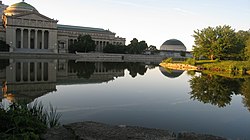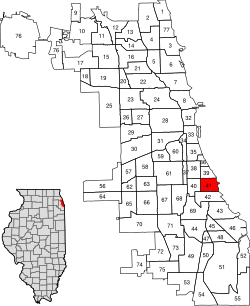Hyde Park, Chicago
| Hyde Park | |
|---|---|
| Community area | |
| Community Area 41 - Hyde Park | |
 |
|
 The official Hyde Park community area (bold black) and the unofficial Hyde Park-Kenwood neighborhood extending into the official Kenwood community area (thin black). |
|
 Location within the city of Chicago |
|
| Coordinates: 41°48′N 87°35.4′W / 41.800°N 87.5900°WCoordinates: 41°48′N 87°35.4′W / 41.800°N 87.5900°W | |
| Country | United States |
| State | Illinois |
| County | Cook |
| City | Chicago |
| Neighborhoods |
List
|
| Area | |
| • Total | 1.65 sq mi (4.27 km2) |
| Population (2010) | |
| • Total | 25,681 |
| • Density | 16,000/sq mi (6,000/km2) |
| Demographics (2010) | |
| • White | 46.7% |
| • Black | 30.4% |
| • Asian | 12.4% |
| • Hispanic | 6.3% |
| • Other | 4.1% |
| Time zone | CST (UTC-6) |
| • Summer (DST) | CDT (UTC-5) |
| ZIP codes | parts of 60615 and 60637 |
| Median household income | $45,335 |
| Source: U.S. Census, Record Information Services | |
Hyde Park is a neighborhood and community area on the South Side of Chicago, Illinois, U.S.A. It is located on the shore of Lake Michigan seven miles (11 km) south of the Chicago Loop.
Hyde Park's official boundaries are 51st Street/Hyde Park Boulevard on the north, the Midway Plaisance (between 59th and 60th streets) on the south, Washington Park on the west, and Lake Michigan on the east. According to another definition, a section to the north between 47th Street and 51st Street/Hyde Park Boulevard is also included as part of Hyde Park, although this area is officially the southern part of the Kenwood community area. The area encompassing Hyde Park and the southern part of Kenwood is sometimes referred to as Hyde Park-Kenwood.
Hyde Park hosts the University of Chicago, the Museum of Science and Industry, and two of Chicago's four historic sites listed in the original 1966 National Register of Historic Places (Chicago Pile-1 and Robie House). In the early 21st century, Hyde Park received national attention for its association with U.S. President Barack Obama.
In 1853, Paul Cornell, a real estate speculator and cousin of Cornell University founder Ezra Cornell, purchased 300 acres (1.2 km2) of land between 51st and 55th streets along the shore of Lake Michigan, with the idea of attracting other Chicago businessmen and their families to the area. The land was located seven miles south of Downtown Chicago in a rural area that enjoyed weather tempered by the lake – cooler in the summer and warmer in the winter. It was conveniently located near the Illinois Central Railroad, which had been constructed two years earlier. Cornell successfully negotiated land in exchange for a railroad station at 53rd Street. Hyde Park quickly became a popular suburban retreat for affluent Chicagoans who wanted to escape the noise and congestion of the rapidly growing city.
...
Wikipedia
